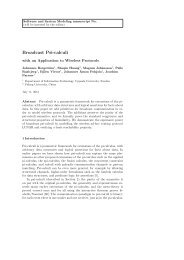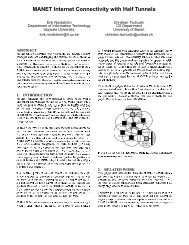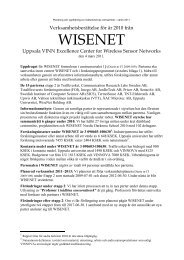Evaluation of Authentication Algorithms for Small Devices
Evaluation of Authentication Algorithms for Small Devices
Evaluation of Authentication Algorithms for Small Devices
You also want an ePaper? Increase the reach of your titles
YUMPU automatically turns print PDFs into web optimized ePapers that Google loves.
3. Practial implementation and<br />
comparisons <strong>of</strong> the results to<br />
the theoretical results<br />
3.1 Introduction<br />
After having finished the theoretical analyzes <strong>of</strong> authentication protocols, the next<br />
logical step was to try to implement at least one or two <strong>of</strong> the analyzed algorithms.<br />
Especially to see if the theoretical results really do matter and behave like <strong>for</strong>eseen<br />
in the real world.<br />
Instead <strong>of</strong> using any special device, the decision was taken to use a regular Nokia<br />
6610 mobile phone.<br />
Not all protocols were implemented, implementations <strong>of</strong> Fiat-Shamir and a SSH-like<br />
protocol using Diffie-Hellman Keyexchange. All sources are available in the Appendix.<br />
3.1.1 The Limited Device<br />
The Nokia 6610 mobile phone was chosen because it comes with builtin Java support.<br />
Meaning there is the possibility to download an execute Java programs that<br />
follow the MIDP 1.0 standard. In addition to that it supports connections to the<br />
Internet via GPRS. Which seemed to be great <strong>for</strong> this kind <strong>of</strong> experiment.<br />
After some research it turned out that the phone supports only the Nokia Series<br />
40 Developer Plat<strong>for</strong>m. Phones <strong>of</strong> this serie have no native Socket support so all<br />
communication has to be done using HTTP-connections. This first seemed to be a<br />
setback.<br />
After having a closer look at a introductive paper provided by Nokia[7] the conclusion<br />
was drawn to use Apache Tomcat with Java Servlets on the server side. This<br />
allows using the same programming language on each side and eliminates the need<br />
<strong>of</strong> native socket support.
















